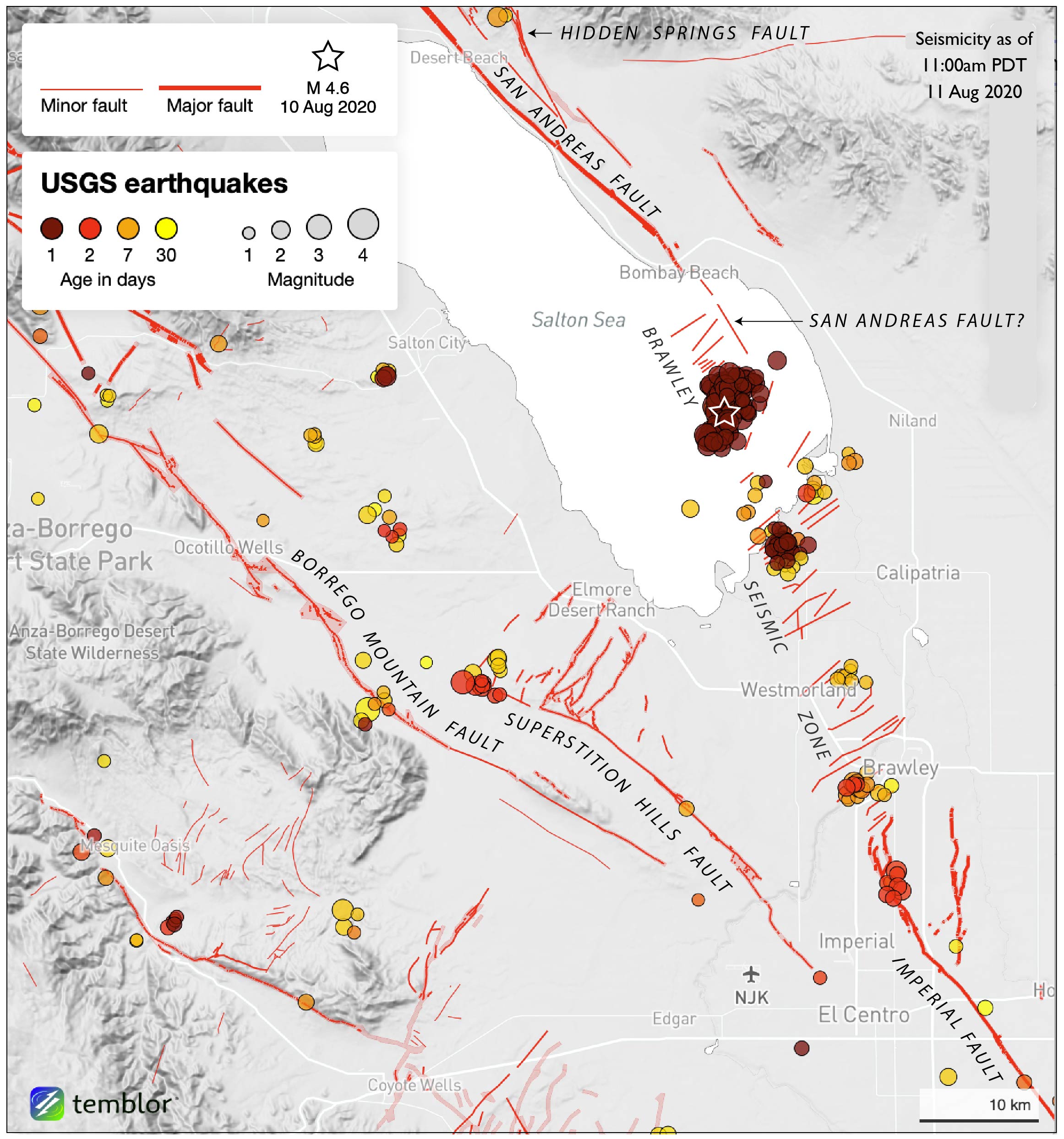Computer simulations show that fluid flow can cause swarms of earthquakes.
By Akash Kharita, Indian Institute of Technology, Roorkee, Temblor science writing extern (@seismo_akash)
Citation: Kharita, A., 2021, Scientists simulate earthquake swarms, Temblor, http://doi.org/10.32858/temblor.178
In August of 2020, a swarm of earthquakes rumbled the southern end of California’s Salton Sea. The swarm consisted of at least 240 earthquakes with the largest registering as a magnitude-4.9, according to the U.S. Geological Survey.
Such swarms, which usually consist of low magnitude earthquakes recurring in the same approximate location, may persist for a few days, months or even years. Earthquake scientists have long suspected that fluids moving along faults cause swarms, but what, specifically, is the trigger? How long will a swarm last? What controls the rate of earthquakes in a particular swarm? These questions have long puzzled seismologists.

Though they may not have all the answers yet, researchers from Stanford University used state-of-the-art computer simulations to explore the relationship between fluids injected into a fault system — either by natural or artificial means — and earthquake occurrence rates. In their study, published in Nature Communications, they found that the ebb and flow of fluid pressure around a fault plays a major role in whether that fault will rupture in an earthquake.
Under pressure
“Earthquakes in many swarms migrate outward or in one direction, a behavior that has been conceptually attributed to moving fluids,” says Eric Dunham, an associate professor at Stanford and coauthor on the paper.
In such a model, any type of fluid — natural groundwater or artificial wastewater — can become trapped along a fault. As the amount of fluid increases in a confined space, the pressure exerted by the fluid in the trap also increases, says Robert Viesca, an associate professor of civil engineering at Tufts University, who was not involved in this study. Eventually, the fluid pressure reaches a threshold value, and a metaphorical valve opens, allowing the fluid to flow. This marks the beginning of the swarm. The newly released fluid moves along the fault (or faults), resulting in a sequence of small earthquakes as the fluid gets stuck, builds up and releases repeatedly — like valves sequentially opening and closing, according to Viesca. This fluid migration, and the accompanying earthquake sequence, lasts as long as high pressures can drive the fluid through the pore spaces. Once the fluid pressure decreases enough, the swarm fades away, often as abruptly as it may have begun.
To explore this “fault valving” model, Weiqiang Zhu, a doctoral student in geophysics at Stanford, and his colleagues built a fault simulation that predicts the relationship between how frequently earthquakes occur during a given swarm and fluid flow rate along faults. Their computer simulation mimics California’s San Andreas Fault, which cuts vertically through the earth’s crust. The team observed how modeled fluid pressure changed over time and found that when it increased, more earthquakes occurred.
This modeled result suggests that in practice, by simply tracking the movement of earthquakes, scientists could “better understand how fluids are moving around within the subsurface, and how pressure is changing,” says Dunham.

Future possibilities
“One of our most important findings is how steady fluid injection, from either a natural source or injection through a well can intermittently trigger pressure pulses that migrate along a fault,” says Dunham.
The study can be extended to include artificial sources of fluid injection, such as wastewater disposal, says Viesca. “It’s not entirely clear how this injection interacts with faults at depth, but it has been known to substantially increase seismicity rates, for instance, in Oklahoma, a region not historically known for its seismicity,” he says.
Viesca’s comments portend Dunham and his colleagues’ the next steps. “We didn’t explore what happens when fluids are injected at much higher rates, as happens during disposal of wastewater from oil and gas operations or during geothermal energy production,” he says. “Our group is currently working on this problem.”
References
Zhu, Weiqiang, Kali L. Allison, Eric M. Dunham, and Yuyun Yang. “Fault valving and pore pressure evolution in simulations of earthquake sequences and aseismic slip.” Nature communications 11, no. 1 (2020): 1-11. DOI: 10.1038/s41467-020-18598-z
- Earthquake science illuminates landslide behavior - June 13, 2025
- Destruction and Transformation: Lessons learned from the 2015 Gorkha, Nepal, earthquake - April 25, 2025
- Knock, knock, knocking on your door – the Julian earthquake in southern California issues reminder to be prepared - April 24, 2025
